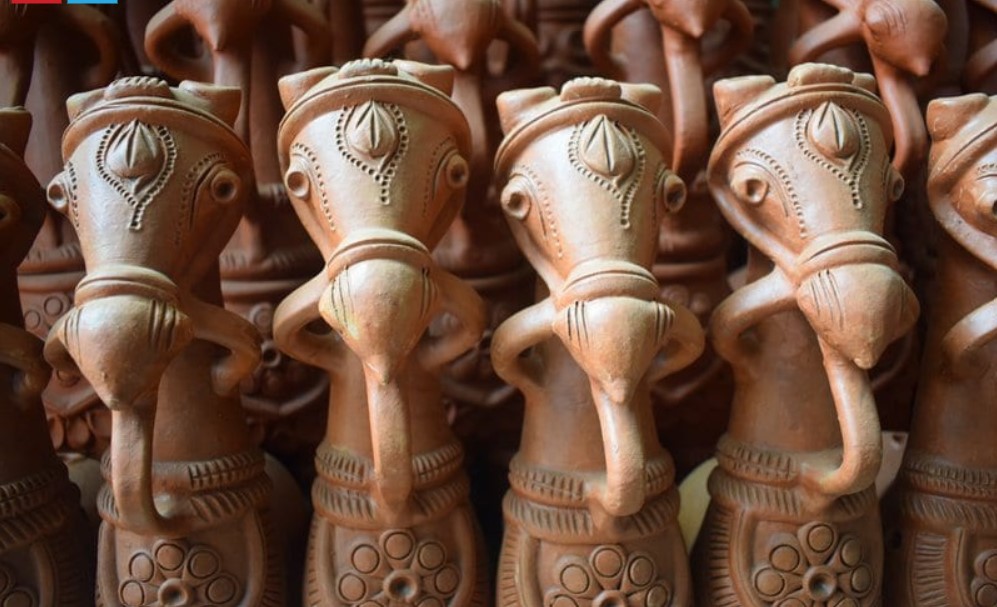
The terracotta horse figurines manufactured solely in the Panchmura village of Bankura district in West Bengal has a specific historical significance and symbolizes religious harmony in this region. The horse has been praised for “its elegant stance and unique abstraction of basic values” and is a mark of artistic excellence of rural handicrafts. This tradition is more than 300 years old and is an icon of tribal animist faith or totemism. It is therefore not surprising that the terracotta horse is the official crest-motif of the All India Handicrafts Board. In urban cities like Kolkata these terracotta horses can be seen adorning several houses as decorative items which are considered to be auspicious. However, the true essence of these figurines lies in their religious and ritualistic significance. In most villages of Bankura, especially in the Rarh region, these red horses made of clay are revered as the Vahana (the deity’s mount) of Dharmathakur or Dharmaraj.
Dharmathakur is represented as a shapeless stone smeared with sindoor (vermillion) and is generally installed under a pipal or banyan tree. He is worshipped by all castes and has been associated with Surya the Sun God. Terracotta figurines of various shapes and sizes, predominantly of the horse, can be seen scattered underneath the trees as a gesture of symbolic sacrifice. These figurines are sacrificed by the village folk to fulfil their aspirations and desires. The horse has always played a prominent role in sacrificial rituals such as the Ashvamedha sacrifice to demonstrate power. However, different sizes of horses made up of clay symbolically sacrificed to fulfil wishes is peculiar to Dharmathakur.
The practice of worshipping Dharma initially began due to the magico-religious beliefs associated with harvesting; however, it soon became intermingled with Aryan beliefs and Buddhist doctrines, which eventually obscured the origin of worshipping the deity. Surya is regarded as a reincarnation of Dharmathathakur because he rides a chariot driven by seven horses. If one closely analyses the gajan (festival) of Dharmaraj where the horse plays a major role, we can see that there is an amalgamation of rituals belonging to different religions. The skull dance performed during the festival does not adhere to the Aryan norms. Recent research suggests that Dharmathakur was originally worshipped by the primitive indigenous people of the region or the Dravidians. Dharmaraj is worshipped and perceived differently in different districts of West Bengal.

The kings of the Mallabhum kingdom of Bishnupur should be attributed to such a diverse cultural and religious amalgamation. They are believed to be the first kings to bring horses in Bengal to improve their cavalry and army. Thus, the figurines inspired by the glorious history of kings, soldiers, and wars, display an erect neck and straight ears, and always look dynamic and alert. The kings were distinguished patrons of art and literature and a tremendous amount of cultural pursuits took place during their reign. The terracotta temples of Bishnupur were constructed under the patronage of these kings. They also commissioned several expert craftsmen to produce the terracotta figurines. Ironically, due to such amalgamation, the Brahmins became the most prominent devotees of Dharmathakur.
The terracotta horse figurine is interpreted as a symbol of religious harmony. These figurines were placed over tombs of Sufi saints and their worshippers did not always belong to the Muslim community. Terracotta horses were also required for the rituals and sacrifices during the worship of Goddess Manasa. Thus, the terracotta horse symbolizes devotion in general.
It is disheartening to watch the growing deprivation and despair of the rural artists of Bankura, who are struggling to keep their tradition alive. One should understand that these craftsmen have no alternative source of income, and everyone in the family has to work to create such crafts. Since the younger generation is moving to cities and urban areas for better prospects, their inability to commit to the labour in creating such figurines is disrupting the process of passing down the skill and the values associated with the craft to the future generations.
A death knell has been struck by the ongoing pandemic as it has completely put an end to this already disappearing cottage industry. Even before the pandemic, the 300-year-old tradition did not undergo a revival of its depressing situation. Fairs, exhibitions, or markets were also not very fruitful or promising because of the scarcity of tourists. A dark abyss has enveloped the struggles of these artists and their voices remain unheard. Due to the declining market and impoverished funds, they have been forced to produce miniatures of the terracotta horses. These artists only desire for some recognition and money to provide for themselves and not encounter the evil face of poverty. Nevertheless, their desires may not bear any positive result in the post-pandemic period, and their tradition might die along with them.


